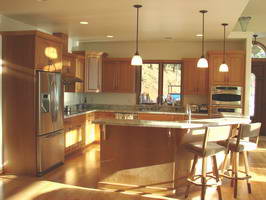How to Build an Environmental-Friendly House with Limited Funds
 '; ';
|
If you’re remodeling a home, do an energy review first to help you figure out what energy efficiency changes should and can be made to your home. In this way you’ll calculate how much energy your home needs. © By: Dave Rongey |
New Jersey school of architecture professor demonstrates to us
How to build an environmental-friendly house with limited funds
Did you know that 2 New York based designers designed an asymmetrical residence with fixed cost of $250,000?
Designers and Jersey City residents Richard Garber (assistant tutor at NJ Institute of Technology University of Architecture and Design in Newark) and Nicole Robertson of GRO Architects in New York City rose to the difficult task of constructing and managing the construction of a single-family house that is a real testament to both progressive design and Eco-Friendly technology.
Denis Carpenter not too long ago acquired a compact vacant lot and, to attempt his interest for the planet, wished a residence that was efficient and easy to maintain.
What’s so exceptional about this home?
– Inside the home, on the ground level, radiant heating under the exposed cement floor heats up the full bathing room and two bed rooms.
– In the loft-like 2nd level, sleek aluminum and stainless steel railings accent the bamboo stairway to the mezzanine, family room and an artfully designed kitchen made with restored kitchen appliances and cabinetry.
– Passive cooling strategies like ceiling fans and clerestory windows allow owners to remain cool during summer and warm during winter.
– The roof consists of 260 square feet of solar panels that deliver around 2,000 kilowatts of energy annually to a battery stored in the basement.
– The root have a 2-foot-square area planted with drought-resist to collect rain .
This single family 1,600-square-foot home was created in six months and won a 2009 American Institute of Architects merit award and the 2010 Green Building of the Year Award from the Jersey City Redevelopment Agency.
Now what? How can you convert your home into an Eco-friendly home without paying too much dollars?
If you’re remodeling a home, do an energy review first to help you figure out what energy efficiency changes should and can be made to your home. In this way you’ll calculate how much energy your home needs.
My favorite Eco-friendly methodology is the passive solar cooling/heating design.
Passive solar means that your home’s windows, walls, and floors can be developed to collect, store, and distribute power from the sun in the form of heat in the wintertime and reject solar heat in the summer season.
Existing buildings can be adapted or “retrofitted” to passively collect and store solar heat too.
The next five factors constitute a complete passive solar home design:
The Collector – The area through which sunlight enters the building (usually windows).
The Absorber – The hard, darkened surface of the storage element. Sunlight hits the surface and is absorbed as heat.
The Thermal Mass – The components that retain or store the heat generated by sunlight below or behind the absorber surface.
The Distributor – The technique by which solar heat circulates from the collection and storage points to different areas of the house.
The Controller – Roof overhangs may be used to shade the aperture area during summer months or Thermostats that signal a fan to turn on.
About the writer – Cynthia Booth contributes articles for the Architecture Career Opportunities blog. It’s a nonprofit web-site dedicated to give help for young architects who need resources for their careers. With this she would like to enhance the consideration on Eco-friendly home design and change the general public conception of energy efficiency.
The following may also be helpful for you:
|
|
Be Careful and Be Safe - Never Work on Energized Circuits!
Consult your Local Building Department about Permits and Inspections for all Electric Wiring Projects.
More articles about Eco-Friendly Home, Electrical, Home Building and Home Electrical Wiring: |
|
| « Previous | Next » |
Add a Switch and Connecting the Wires |
Lighting Control With A Remote Control Module |














